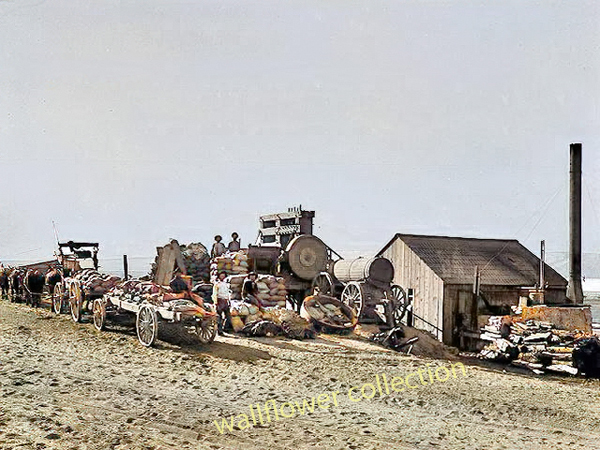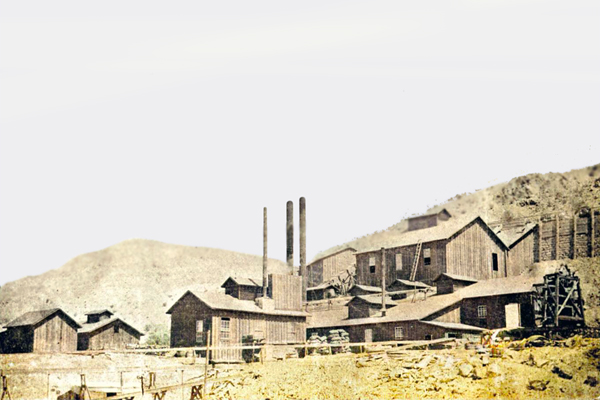Mines & Mills

Hawley Mill, Daggett 1885 - Base image courtesy Orange County Archives
AFTER LATE 1882, the history of the town becomes sketchy: only a few issues of the Calico, Colton, and San Bernardino newspapers exist, and other sources provide little information. But other publications, well preserved, give detailed accounts of the growth of mining and milling in the district.
All during the fall of 1882, as Southern Pacific construction crews neared the district, capitalists were building up their properties. Awaiting the railroad and ore buyers, one mine stockpiled ore worth up to $125 a ton. The Bismarck packed its ore to town on burros for shipment to Oro Grande. In East Calico, a dozen men were building a road up the canyon to the Oriental and Occidental. At the King (December, 1882), the Mellens and their crew completed an enormous tramway trestle jutting from the hillside and finished a long chute that carried ore to huge bins. When the Mellens finally dumped some ore down the chute, "we had every man, woman and child out in the street looking up at the mountain. After a moment of silence, they saluted in true American fashion, with a mighty cheer."
Throughout early 1883, roads, tramways, chutes, and mills were going up everywhere. A boiler and engine were in place at the site of the Oriental mill, near the river. The labor forces were still fairly small, about four to 16, but the district abounded in small mines.
Yet several of these companies would build substantial works. The Mammoth (May, 1883) had a 600-foot tramway and a car track running to a 200-lion ore bin; the Silver Odessa, meanwhile, had a good, comfortable bunkhouse and boardinghouse. Under construction were a road, ore bins, and turntable. As the Print reported, all "the boys in the camp are at work. . . . There is work for all here that will work, and we have no use for bums." Work was advancing so rapidly that by May, the "roar of the ore cars ascending and descending the chute, and the loud reports of blasts can be heard at the mine at all hours of the day" as several companies blasted away bluffs.

Silver King 1885 - Original image courtesy Orange County Archives
The Silver King Mine was indeed monarch of the district. One reporter predicted that its output would "eventually place it foremost among the great mines on the Pacific coast. . . ." The King was sending out 20 tons of ore to Oro Grande daily. Despite 115-degree heat in July, 1883, the work force rose from 40 to 55 in only a few weeks. The Oro Grande mill was turning out $50,000 in bullion a month; the 100th bar was carefully packed up and sent to Milwaukee, the home of the largest group of investors. In early 1884, Hues Thomas and John C. King brought to San Bernardino 18 "immense" bars worth $31,570--the result of a 14-day run of the mill. The Index bragged that citizens could view "this immense deposit of silver bullion," the largest shipment of bullion sent from Southern California, at the express office. By mid-February, the King's shaft was down 600 feet.
By now, early 1884, about 300 miners and chloriders were at work. Though the plants were small, processing ore was as big an activity as mining. In 1883, Hawley's mill, eight miles from town, had shipped out $300,000 in bullion to San Francisco, and the Oriental mill had sent out $200,000 in silver. In 10 months, the Oro Grande mill had turned out $400,000 in bullion from the King alone.
Not even the burning of the business section hindered the district's advance. For as the Print observed, "the business men had the fullest confidence in the stability of the camp. Even when their business places were in ashes their confidence did not slack," and they rebuilt completely. ". . . The town is now looking substantial, lively and prosperous. . . . Calico's colors are not the kind that easily fade." In fact, families were pouring into the district.
The Print was ever the optimist. It must have expressed the feelings of many in May, 1884, when it declared that at no time "has the camp appeared as lively as at the present time. All the principal mines are looking well and working their full complement of men, while the chloriding element is doing a wonderful work in the development of property that a year ago was considered relatively worthless. By slow degrees our prospectors are beginning to realize that every square yard of ground within the mineral belt must be inspected. . . ."
Technology was now beginning to spur the boom. The construction of several small mills and the railroad had been a start. When the Daggett Sampling Works started up in June, 1884, with good results, the Print pointed out that the Daggett-Calico area was becoming an important business center. ". . . . Our merchants and business men should awaken to the situation and be prepared to meet the demands of the trade that will be centered here for 150 miles around. A bank should be started here at once, for a business of $100,000 monthly requires it. These are solid facts, as solid as the ponderous silver bars that are daily dumped into our Express office." The King was in the vanguard of making improvements. It considered a plan to lay a pipeline from Calico dry lake to a reservoir in the halls, from where it could be piped into town. As soon as poles arrived, the King would build a telephone line from, Daggett and its mill to its mine. It also planned to lay a pipeline to carry oil from Daggett to its mill and install an engine to operate lathes and other machinery to make repairs. (Apparently, only the phone line was built.)
Certain traits of the district required labor-saving devices. For one thing, mining did not slacken during the summers, as it did in other desert areas. In one week alone during the summer of 1884, Wells, Fargo shipped out $12,775 in bullion from the King, $5,287 from the Garfield. The shipments that season netted $155,470.
Then, too, chloriders were a force to be reckoned with. When the leases of 20 chloriders expired at one mine, "the life and activity existing in that vicinity during the summer" diminished greatly. The chloriders had taken out $40,000 worth of ore, of which they paid the owner $9,000. In some cases, these independents "threw $75 rock over the waste dump, as it would not pay them wages after they had paid all the expenses of mining, hauling, and milling the ore. . . ." Chloriders could be notoriously wasteful. One solution was a mill where they could process their ore cheaply. And that mill would be Barber's mill, built just below the townsite. A foundation and part of the framework were built in late 1884; a private home, lodging house, boardinghouse, superintendent's office, and assay office were under construction. A test run of the machinery was made in December "to get everything in good running order before commencing on the hundreds of tons of ore piled up on the platform. . . ." Two months later, Barber's mill was running all the time on "custom" (outsiders') ore. The plant was called "one of the most complete, best arranged and best managed silver mills on the coast, of its size." The mill even had a good, abundant supply of water. Five more stamps were added in March.
Because of the district's rugged terrain, the mines were grouped into several canyons above town. Here's how the district shaped up in late 1884:
THE WEST CALICO mines lay several miles northwest of camp. The Waterloo and Sue were the chief properties. The Sue operated near the top of the wall of a deep canyon, 500 feet deep in place. A narrow tramway, nearly 300 feet long, ran nearly straight up; cars named "Go Devils," powered by a hand windlass, carried ore to the canyon floor. There, buildings were due to replace the tents used for lodging and boarding.
THE EAST CALICO mines operated to the northeast of Calico, in Garfield (since named Odessa) Canyon. Included were several moderate producers: the Garfield, Snow Bird, Odessa (Silver Odessa), Blackfoot, and Bismarck; slightly to the west of the canyon lay the Thunderer and Occidental. The terrain was so rugged that ores were said to be "virtually quarried out of the hills." The (Silver) Odessa made especially great progress during early 1885. The newly built ore bins could hold 140 tons; a 300-foot chute led to a solidly built ore house, which "is very pleasantly situated on a prominent ridge from which point the ore assorters, on a fervent summer's day, can gaze upon the hazy landscape between Calico and Daggett, and relieve their eyes with a refreshing view of the placid surface of 'Dry Lake.'. . . ." From the ore house, where 20 men worked sorting ore, a 600-foot track led to the main tunnel.
The East Calico mines supported large forces. In early 1885, the Bismarck employed 24 men, the Garfield 20 to 30, and the Occidental 34 (March).
IMMEDIATELY NORTH OF TOWN, on the slopes of Wall Street Canyon and on nearby King Mountain, were the Oriental, Burning Moscow, and Silver King, among other properties. It was said that to "know the King is to know the district. . . ." Overlooking town, at the head of Main Street, the King would remain the district's leading producer. It was paying as much as $30,000 a month in dividends in early 1885 and had produced $702,650 in bullion from early 1884 to mid- 1885. The property had produced so much ore, ironically, that several of its 100 workers had to be laid off to give its teams a chance to move 3,000 tons of ore that had accumulated on its dumps. One writer praised this "excellent mine" for having been "unceasingly, quietly and unostentatiously" operated by the Oro Grande company for two years; the mine was being "cautiously and systematically developed," though the district's deposits in general were gouged out more than mined.
The King was quite a hive of industry. The men, who received a customary $3.50 a shift (of nine hours), worked day and night, even on Sundays. The men were free to board where they pleased, "promptness and sobriety being only required by the company." The operation consumed one ton of candles a month, the company paid $20,000 a month in wages, and water used for drilling and drinking and timber (brought from Arizona) cost the concern heavily. Working conditions, however, were fair at best. The lower levels were so warm that candles burned rapidly. Dust filled the main and side tunnels. An ore car would raise a cloud of dust "that the initiated would think must be unhealthful" to miners.